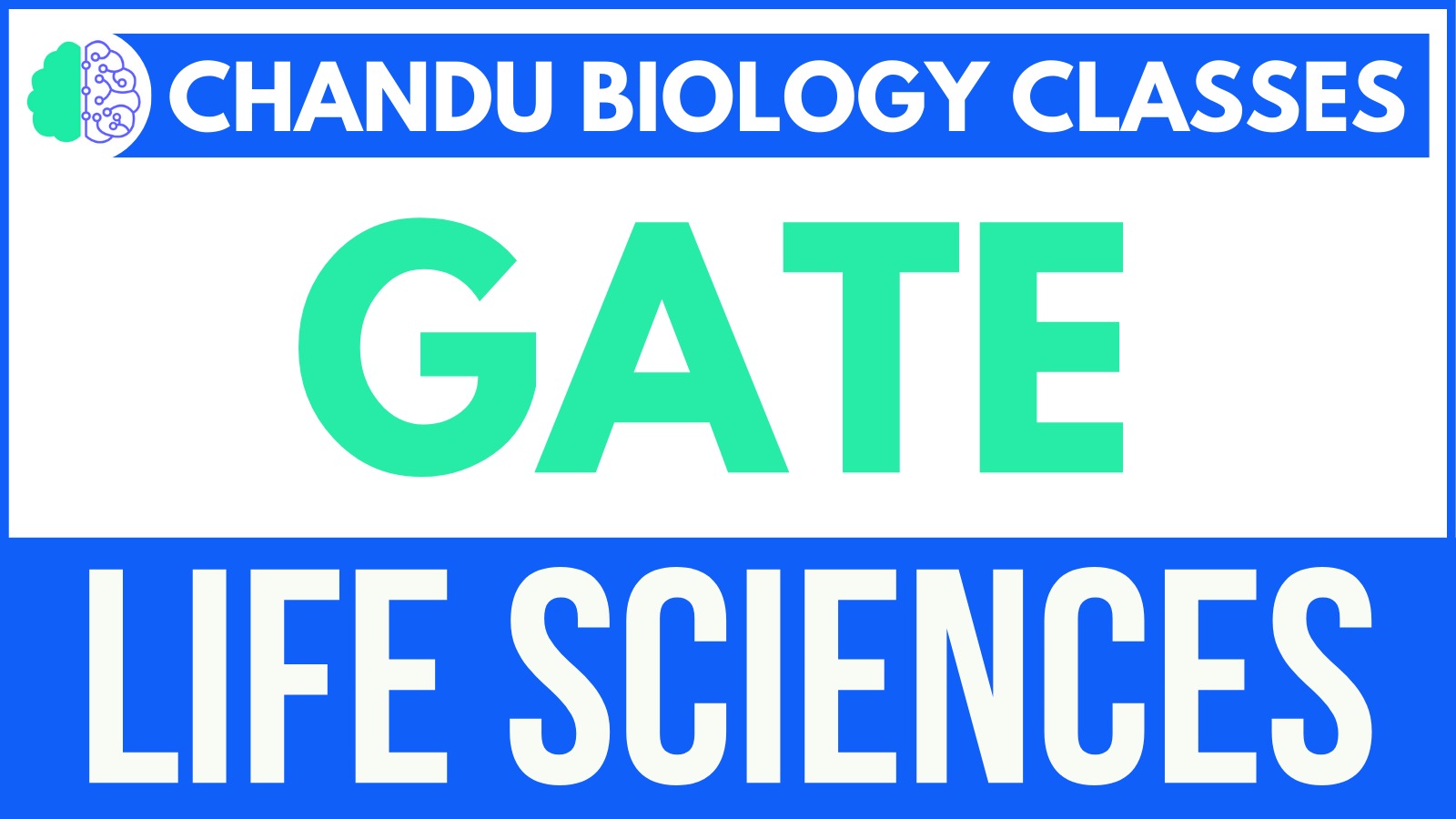The Graduate Aptitude Test in Engineering (GATE) is one of the most crucial exams for students aspiring to pursue higher education and research careers in science and engineering. The GATE Life Sciences (XL) exam serves as a gateway for postgraduate programs and career opportunities in research and academia.
This article provides a detailed guide on the GATE Life Sciences 2025 examination, including its syllabus, preparation strategies, and an overview of Chandu Biology Classes, one of the best coaching centers for GATE aspirants.
Understanding the GATE Life Sciences 2025 Examination
The GATE Life Sciences exam is structured to evaluate a candidate’s knowledge in various disciplines of life sciences. The test comprises a mix of mandatory and optional sections, enabling candidates to customize their exams based on their strengths.
Exam Structure and Pattern
The GATE Life Sciences exam consists of three sections:
- General Aptitude (GA) – This section is common to all GATE papers and evaluates the candidate’s reasoning and language skills. It consists of 10 questions worth 15 marks.
- Chemistry (Section P) – A mandatory section for all Life Sciences candidates, covering fundamental and advanced chemistry topics. This section carries 25 marks.
- Optional Sections (Q to U) – Candidates must choose any two sections from:
- Biochemistry (XL-Q)
- Botany (XL-R)
- Microbiology (XL-S)
- Zoology (XL-T)
- Food Technology (XL-U)
Each selected section contributes 30 marks, making a total of 60 marks.
The exam consists of 65 questions for a total of 100 marks, with a duration of 3 hours. The questions include Multiple Choice Questions (MCQs), Multiple Select Questions (MSQs), and Numerical Answer Type (NAT) questions. While MCQs have negative markings, MSQs and NAT questions do not.
GATE Life Sciences 2025 Syllabus Overview
A clear understanding of the syllabus is crucial for efficient preparation. Below is a concise breakdown:
1. General Aptitude
- Verbal Ability: English grammar, sentence completion, analogies, critical reasoning, and verbal deduction.
- Numerical Ability: Basic mathematics, numerical computation, and data interpretation.
2. Chemistry (Section P)
- Atomic structure and periodicity
- Chemical bonding
- Organic reaction mechanisms
- Biomolecules and biochemistry
3. Biochemistry (XL-Q)
- Enzyme kinetics and regulation
- DNA replication, transcription, and translation
- Cell structure and organelles
4. Botany (XL-R)
- Plant anatomy and morphology
- Genetics and genomics
- Plant pathology and ecology
5. Microbiology (XL-S)
- Microbial taxonomy and diversity
- Microbial diseases and host-pathogen interaction
- Microbial genetics
6. Zoology (XL-T)
- Evolution and genetics
- Animal anatomy and physiology
- Parasitology and immunology
7. Food Technology (XL-U)
- Food chemistry and nutrition
- Food Microbiology
- Food engineering
For the detailed syllabus, students should refer to official GATE sources and standard textbooks.
Effective Study Strategies for GATE Life Sciences 2025
✅ Understand the Exam Pattern
Familiarize yourself with the types of questions, marking scheme, and exam format to plan your strategy effectively.
✅ Create a Study Plan
- Divide your preparation into monthly, weekly, and daily targets.
- Allocate more time to high-weightage topics.
- Focus on revision and practice to strengthen weak areas.
✅ Refer to Standard Books
A strong conceptual foundation is essential. Use trusted books for reference (see book recommendations below).
✅ Solve Previous Year Papers
- Helps in understanding question trends.
- Improves time management and problem-solving speed.
✅ Enroll in Mock Tests
- Take full-length tests to simulate exam conditions.
- Identify weak areas and work on improvement.
Top Coaching Institute: Chandu Biology Classes
Many aspirants opt for coaching to enhance their preparation. One of the most recommended coaching centers for GATE Life Sciences is Chandu Biology Classes.
Why Choose Chandu Biology Classes?
✔ Expert Faculty: Highly experienced teachers with strong academic backgrounds.
✔ Comprehensive Study Material: Well-structured notes, practice questions, and revision guides.
✔ Regular Tests and Assessments: Weekly and monthly tests to track progress.
✔ Personalized Attention: Small batch sizes ensure focused mentorship.
✔ Doubt Clearing Sessions: One-on-one doubt-solving classes.
For more information, visit Chandu Biology Classes’ official website.
MCQs for GATE Life Sciences Practice
1. Which enzyme is responsible for DNA replication?
- a) DNA polymerase
- b) RNA polymerase
- c) Ligase
- d) Topoisomerase
Answer: a) DNA polymerase
2. Which microorganism is used in the production of antibiotics?
- a) Escherichia coli
- b) Penicillium notatum
- c) Saccharomyces cerevisiae
- d) Lactobacillus acidophilus
Answer: b) Penicillium notatum
Regular practice with MCQs and previous year questions will improve accuracy and confidence.
Recommended Books for GATE Life Sciences Preparation
| Subject | Recommended Books |
|---|---|
| Biochemistry | Lehninger Principles of Biochemistry – Nelson & Cox |
| Botany | Plant Physiology – Taiz & Zeiger |
| Microbiology | Prescott’s Microbiology – Willey & Sherwood |
| Zoology | Integrated Principles of Zoology – Hickman |
| Chemistry | Organic Chemistry – Morrison & Boyd |
Final Tips for Success in GATE Life Sciences 2025
✔ Start early and be consistent.
✔ Focus on conceptual clarity rather than rote learning.
✔ Practice regularly with mock tests and previous papers.
✔ Join a coaching institute like Chandu Biology Classes for structured learning.
✔ Stay positive and manage stress effectively.
GATE EXAM : What’s New
- 1 New Paper – Data Science & Artificial Intelligence. The total number of subjects has increased to 30.
- In another newly introduced change, students applying for GATE EXAM 2025 can also opt for two different papers from the prescribed set of combinations.
- Eligibility criteria to appear for GATE-2025 is relaxed from the minimum of 10+2+4 (ongoing) to a minimum 10+2+3 (ongoing), enabling even those in the third year of their undergraduate studies to appear for the examination, thus providing an additional opportunity to candidates to improve their performance to secure better career options.
- All test papers of GATE EXAM 2025 will be entirely objective type. Patterns of questions may include (i) Multiple Choice Questions (MCQ), (ii) Multiple Select Questions (MSQ), and/or (iii) Numerical Answer Type (NAT) questions.
Subjects With Code:
- XL-P – Chemistry
- XL-Q – Biochemistry
- XL-R – Botany
- XL-S – Microbiology
- XL-T – Zoology
- XL-U – Food Technology
GATE 2025 ELIGIBILITY
Anyone who has completed 10+2+2 or 10+3+1 and currently studying in 3rd or higher years of any undergraduate degree program OR has already graduated in any government-approved degree program in Engineering / Technology / Architecture / Science / Commerce / Arts is eligible to apply for GATE.
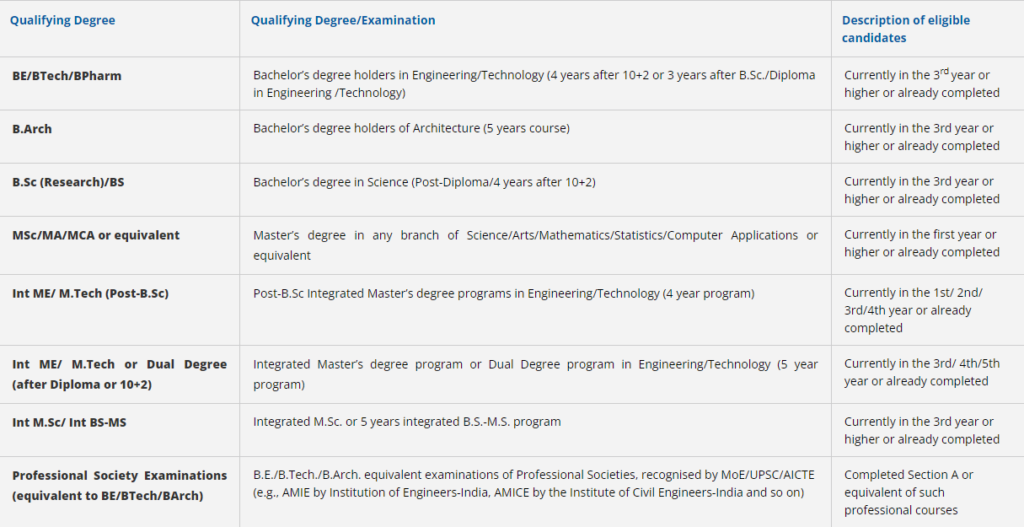
GATE Exam Pattern 2025
The given GATE exam highlights contain the mode of exam, duration, marking scheme, and more that help aspirants to make a well-planned preparation strategy.
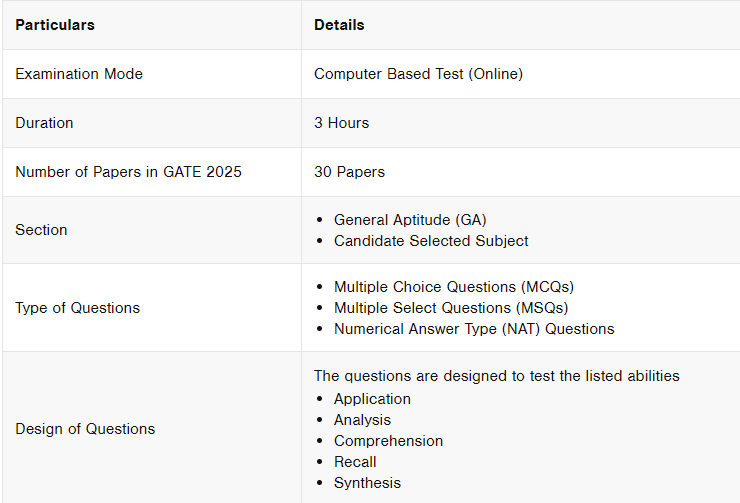
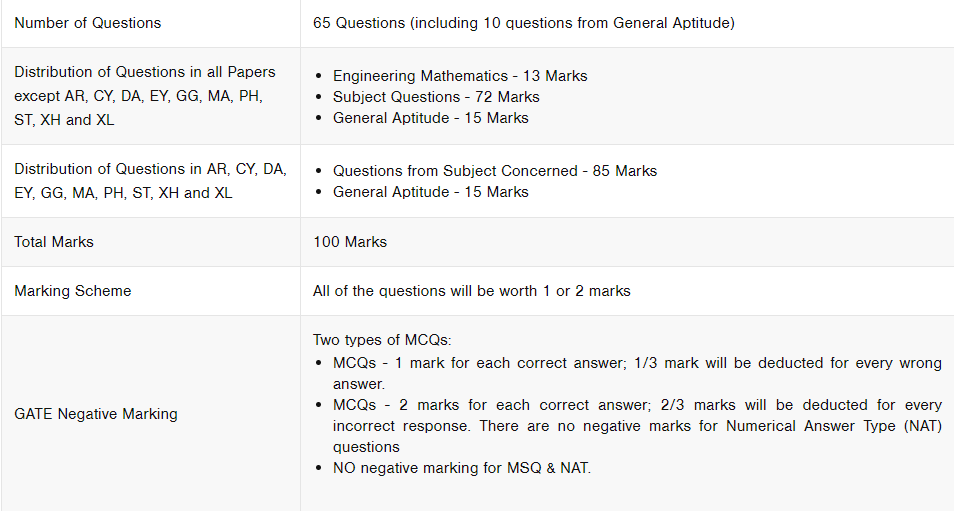
GATE Exam Pattern 2025 – Paper Code Wise Subject Weightage

GATE life sciences qualifying marks?
GATE 2025 Exam Pattern – Marking Scheme
Check the table for the GATE total marks for Mechanical, Civil, Computer Science, Electrical, and other courses.
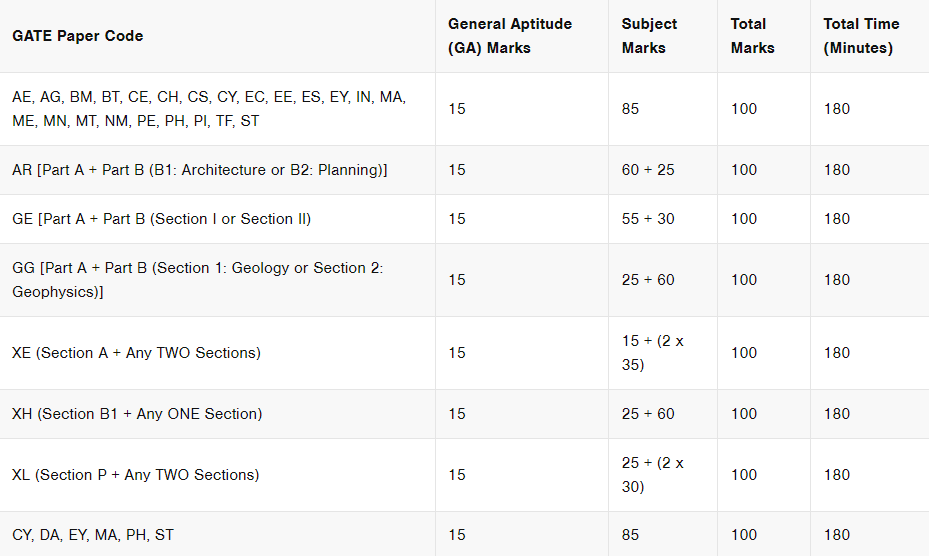
GATE 2025 XL-P Chemistry Syllabus (Compulsory)
Section 1: Atomic Structure and Periodicity
Planck’s quantum theory, wave particle duality, uncertainty principle, comparison between Bohr’s model and quantum mechanical model of hydrogen atom, electronic configuration of atoms and ions. Hund’s rule and Pauli’s exclusion principle.
Periodic table and periodic properties: ionization energy, electron affinity, electronegativity and atomic size.
Section 2: Structure and Bonding
Ionic and covalent bonding, MO and VB approaches for diatomic molecules, VSEPR theory and shape of molecules, hybridization, resonance, dipole moment, structure parameters such as bond length, bond angle and bond energy, hydrogen bonding and van der Waals interactions. Ionic solids, ionic radii and lattice energy (Born‐Haber cycle). HSAB principle.
Section 3: s, p and d Block Elements
Oxides, halides and hydrides of alkali, alkaline earth metals, B, Al, Si, N, P, and S. General characteristics of 3d elements. Coordination complexes: valence bond and crystal field theory, color, geometry, magnetic properties and isomerism.
Section 4: Chemical Equilibria
Osmotic pressure, elevation of boiling point and depression of freezing point, ionic equilibria in solution, solubility product, common ion effect, hydrolysis of salts, pH, buffer and their applications. Equilibrium constants (Kc, Kp and Kx) for homogeneous reactions.
Section 5: Electrochemistry
Conductance, Kohlrausch law, cell potentials, EMF, Nernst equation, thermodynamic aspects and their applications.
Section 6: Reaction Kinetics
Rate constant, order of reaction, molecularity, activation energy, zero, first and second order kinetics, catalysis and elementary enzyme reactions. Reversible and irreversible inhibition of enzymes.
Section 7: Thermodynamics
Qualitative treatment of state and path functions, First law, reversible and irreversible processes, internal energy, enthalpy, Kirchoff equation, heat of reaction, Hess’s law, heat of formation. Second law, entropy and free energy. Gibbs‐Helmholtz equation, free energy change and spontaneity, Free energy changes from equilibrium constant.
Section 8: Structure-Reactivity Correlations and Organic Reaction Mechanisms
Acids and bases, electronic and steric effects, Stereochemistry, optical and geometrical isomerism, tautomerism, conformers and concept of aromaticity. Elementary treatment of SN1, SN2, E1, E2 and radical reactions, Hoffmann/Saytzeff rules, addition reactions, Markownikoff rule and Kharasch effect. Elementary hydroboration reactions. Grignard’s reagents and their uses. Aromatic electrophilic substitutions, orientation effect as exemplified by various functional groups. Identification of common functional groups by chemical tests.
Section 9: Chemistry of Biomolecules
Amino acids, proteins, nucleic acids and nucleotides. Peptide sequencing by chemical and enzymatic proteolytic methods. DNA sequencing by chemical and enzymatic methods. Carbohydrates (upto hexoses only). Lipids (triglycerides only). Principles of biomolecule purification-Ion exchange and gel filtration chromatography. Identification of these biomolecules and Beer-Lambert’s law.
GATE 2025 XL-Q Biochemistry Syllabus
Section 1 – Organization of life; Importance of water; Structure and function of biomolecules: Amino acids, Carbohydrates, Lipids, Proteins and Nucleic acids; Protein structure, folding and function: Myoglobin, Hemoglobin, Lysozyme, Ribonuclease A, Carboxypeptidase and Chymotrypsin.
Section 2 – Enzyme kinetics including its regulation and inhibition, Vitamins and Coenzymes; Metabolism and bioenergetics; Generation and utilization of ATP; Metabolic pathways and their regulation: glycolysis, TCA cycle, pentose phosphate pathway, oxidative phosphorylation, gluconeogenesis, glycogen and fatty acid metabolism; Metabolism of Nitrogen containing compounds: nitrogen fixation, amino acids and nucleotides. Photosynthesis: Calvin cycle.
Section 3 – Biochemical separation techniques: ion exchange, size exclusion and affinity chromatography, Characterization of biomolecules by electrophoresis, UV-visible and fluorescence spectroscopy and Mass spectrometry.
Section 4 – Cell structure and organelles; Biological membranes; Action potential; Transport across membranes; Membrane assembly and Protein targeting; Signal transduction; Receptor-ligand interaction; Hormones and neurotransmitters.
Section 5 – DNA replication, transcription and translation; Biochemical regulation of gene expression; Recombinant DNA technology and applications: PCR, site directed mutagenesis and DNA-microarray, Next generation sequencing; Gene silencing and editing.
Section 6 – Immune system: Innate and adaptive; Cell of the immune system; Active and passive immunity; Complement system; Antibody structure, function and diversity; B cell and T Cell receptors; B cell and T cell activation; Major histocompatibilty complex; Immunological techniques: Immuno diffusion, immune-electrophoresis, RIA and ELISA, flow cytometry; monoclonal antibodies and their applications.
GATE 2025 XL-R Botany Syllabus
Section 1: Plant Systematics- Botanical nomenclature, history of plant taxonomy, diversity and classification of plants, APG system of plant classification; phylogenetics and cladistics, molecular taxonomy and DNA barcoding; Centers for plant taxonomy and herbaria in India.
Section 2: Plant Anatomy- Anatomy of root, stem and leaves, floral organs, embryo and young seedlings, Primary and secondary meristems, stellar organization, vascular system and their ontogeny, xylem and phloem structure, secondary growth in plants and wood anatomy, plant cell structure and differences from animal cells.
Section 3: Plant development; cell and tissue morphogenesis- Life cycle of an angiosperm, development of male and female gametophyte; cell fate determination and tissue patterning; spacing mechanisms in trichomes and stomata. Embryogenesis, organization and function of shoot and root apical meristems. Transition to flowering: photoperiodism and vernalization, ABC model of floral organ patterning, pollen germination, double fertilization, seed development; Xylem and phloem cell differentiation, photomorphogenesis; phytochrome, cryptochrome, phototropin. Role of auxin, cytokinin, gibberellins, and brassinosteroids on plant development.
Section 4: Plant physiology and biochemistry- Plant water relations, mechanisms of uptake and transport of water, ions, solutes from soil to plants, apoplastic and symplastic transport mechanisms. Mechanism of stomatal movements, nitrogen metabolism, photosynthesis; C3, C4 and CAM cycles, photorespiration, respiration: glycolysis, TCA cycle and electron transport chain. Plant responses and mechanisms of abiotic stresses including drought, salinity, freezing and heat stress, metal toxicity; role of abscisic acid in abiotic stresses. Structure and function of biomolecules (proteins, carbohydrates, lipids, nucleic acid), enzyme. Structure and biosynthesis of major plant secondary metabolites (alkaloids, terpenes, phenylpropanoids, flavonoids). Biosynthesis, mechanism of action and physiological effects of auxin, cytokinin, gibberellic acids, brassinosteroid, ethylene, strigolactone, abscisic acid, salicylic and jasmonic acid. Senescence and programmed cell death.
Section 5: Genetics and Genomics – Cell cycle and cell division. Principles of Mendelian inheritance, linkage, recombination, genetic mapping; extra chromosomal inheritance; Introduction to epigenetics; gene silencing- transgene silencing, post transcriptional gene silencing, miRNA and siRNA; evolution and organization of eukaryotic genome structure, gene expression, gene mutation and repair, chromosomal aberrations (numerical: euploidy and aneuploidy and structural: deletion, duplication, inversion, translocation), transposons. Model organisms for functional genetics and genomics; Introduction to transcriptomics, proteomics and metabolomics.
Section 6: Plant Breeding, Genetic Modification, Genome Editing- Principles, methods – selection, hybridization, heterosis; male sterility, genetic maps and molecular markers, embryo rescue, haploid and doubled haploids, plant tissue culture: micropropagation, embryo culture and in vitro regeneration, somatic embryogenesis, artificial seed, cryopreservation, somaclonal variation, somatic cell hybridization, marker-assisted selection, gene transfer methods viz. direct and vector-mediated, generation of transgenic plants; Introduction to genome editing:
CRISPR/Cas9, Cre-Lox system to generate chimeras; plastid transformation; chemical mutagenesis.
Section 7: Economic and applied Botany- A general account of economically and medicinally important plants- cereals, pulses, plants yielding fibers, timber, sugar, beverages, oils, rubber, pigments, dyes, gums, drugs and narcotics. Economic importance of algae, fungi, lichen and bacteria. Major Indian cash crops. Effect of industrialization on agricultural botany such as plastic on fiber economy. Genetically modified crops and its regulation eg. Bt cotton, Bt brinjal golden rice etc.
Section 8: Plant Pathology – Nature and classification of plant diseases, diseases of important crops caused by fungi, bacteria, nematodes and viruses, and their control measures (chemical and biological) mechanism(s) of pathogenesis, resistance: basal, systemic, induced systemic resistance, gene for gene concept. Molecular detection of pathogens; plant-microbe interactions: symbionts and mycorrhiza, pathogens and pests. Signaling pathways in plant defence response; salicylic acid (SA) and jasmonic acid (JA) in plant-pathogen and plant-herbivore interaction, necrosis; host-parasitic plant interaction (such as Cuscuta).
Section 9: Ecology and Environment- Ecosystems – types, dynamics, degradation, biogeochemical cycles, ecological succession; food webs and energy flow through ecosystem; vegetation types of the world, Indian vegetation types and biogeographical zones, climate and flora endemism; pollution and global climate change, speciation and extinction, biodiversity and conservation strategies, ecological hotspots, afforestation, habitat restoration; plant interactions with other organisms; epiphytes, parasites and endophytes.
GATE 2025 XL-S Microbiology Syllabus
Section 1: Historical Perspective – Discovery of microbial world; Landmark discoveries relevant to the field of microbiology; Controversy over spontaneous generation; Role of microorganisms in transformation of organic matter and in the causation of diseases.
Section 2: Methods in Microbiology- Pure culture techniques; Principles of microbial nutrition; Enrichment culture techniques for isolation of microorganisms; antigen and antibody detection methods for microbial diagnosis; Light-, phase contrast-, fluorescence- and electron-microscopy; PCR, real-time PCR for quantitation of microbes; Next generation sequencing technologies in microbiology.
Section 3: Microbial Taxonomy and Diversity – Bacteria, Archea and their broad classification; Eukaryotic microbes: Yeasts, molds and protozoa; Viruses and their classification; Molecular approaches to microbial taxonomy and phylogeny.
Section 4: Prokaryotic Cells: Structure and Function – Prokaryotic Cells: cell walls, cell membranes and their biosynthesis, mechanisms of solute transport across membranes, Flagella and Pili, Capsules, Cell inclusions like endospores and gas vesicles; Bacterial locomotion, including positive and negative chemotaxis.
Section 5: Microbial Growth – Definition of growth; Growth curve; Mathematical expression of exponential growth phase; Measurement of growth and growth yields; Synchronous growth; Continuous culture; Effect of environmental factors on growth; Bacterial biofilm and biofouling.
Section 6: Control of Micro-organisms – Disinfection and sterilization: principles, methods and assessment of efficacy.
Section 7: Microbial Metabolism – Energetics: redox reactions and electron carriers; Electron transport and oxidative phosphorylation; An overview of metabolism; Glycolysis; Pentose-phosphate pathway; Entner-Doudoroff pathway; Glyoxalate pathway; The citric acid cycle; Fermentation; Aerobic and anaerobic respiration; Chemolithotrophy; Photosynthesis; Calvin cycle; Biosynthetic pathway for fatty acids synthesis; Common regulatory mechanisms in synthesis of amino acids; Regulation of major metabolic pathways.
Section 8: Microbial Diseases and Host-Pathogen Interaction – Normal microbiota; Classification of infectious diseases; Reservoirs of infection; Nosocomial infection; Opportunistic infections; Emerging infectious diseases; Mechanism of microbial pathogenicity; Nonspecific defense of host; Antigens and antibodies; Humoral and cell-mediated immunity; Vaccines; passive immunization; Immune deficiency; Human diseases caused by viruses, bacteria, and pathogenic fungi.
Section 9: Chemotherapy/Antibiotics – General characteristics of antimicrobial drugs; Antibiotics: Classification molecular mechanism of mode of action and resistance; Antifungal and antiviral drugs.
Section 10: Microbial Genetics – Types of mutation; UV and chemical mutagens; Selection of mutants; Ames test for mutagenesis; Bacterial genetic system: transformation, conjugation, transduction, recombination, plasmids,
transposons; DNA repair; Regulation of gene expression: repression and induction; Operon model; Bacterial genome with special reference to E.coli; Phage λ and its life cycle; RNA ; mutation in virus genomes, virus recombination and reassortment; Basic concept of microbial genomics.
Section 11: Microbial Ecology – Microbial interactions; Carbon, Sulphur and nitrogen cycles; Soil microorganisms associated with vascular plants; Bioremediation; Uncultivable microorganisms; basic concept of metagenomics and metatranscriptomics.
GATE 2025 XL-T Zoology Syllabus
Section 1: Animal Diversity – Distribution, systematics and classification of animals, phylogenetic relationships (based on classical and molecular phylogenetic tools).
Section 2: Evolution – Origin and history of life on earth, theories of evolution, natural selection, adaptation, speciation.
Section 3: Genetics – Basic Principles of inheritance, the molecular basis of heredity, sex determination and sex-linked characteristics, cytoplasmic inheritance, linkage, recombination and mapping of genes in eukaryotes, population genetics, genetic disorders, roles of model organisms in understanding genetic principles.
Section 4: Biochemistry and Molecular Biology –Nucleic acids, proteins, lipids and carbohydrates; replication, transcription and translation, Krebs cycle, glycolysis, enzyme catalysis, hormones and their actions, roles of vitamins and minerals.
Section 5: Cell Biology – Basic principles of cellular microscopy, the structure of the cell, cytoskeletal organization, cellular organelles and their structure and function, cell cycle, cell division, chromosomes, and chromatin structure.
Section 6: Gene expression in Eukaryotes – Eukaryotic genome organization and regulation of gene expression, transposable elements.
Section 7: Animal Anatomy and Physiology –Comparative physiology, the respiratory system, Muscular system, circulatory system, digestive system, the nervous system, the excretory system, the endocrine system, the reproductive system, the skeletal system.
Section 8: Parasitology and Immunology- Nature of parasite, host-parasite relation, protozoan and helminthic parasites, the immune response, cellular and humoral immune response.
Section 9: Development Biology – Gametogenesis, Embryonic development, cellular differentiation, organogenesis, metamorphosis, Model organisms used in developmental biology, the genetic and molecular basis of development, stem cells.
Section 10: Ecology – The ecosystem, Animal distribution, ecological niche and its contribution to ecological diversity, the food chain, population dynamics, species diversity, zoogeography, biogeochemical cycles, conservation biology, ecotoxicology.
Section 11: Animal Behaviour – Type of behaviors, courtship, mating and territoriality, instinct, learning and memory, social behavior across the animal taxa, communication, pheromones, evolution of behavior in animals.
GATE 2025 XL-U Food Technology Syllabus
Section 1: Food Chemistry and Nutrition – Carbohydrates: structure and functional properties of mono-, oligo-, & poly- saccharides including starch, cellulose, pectic substances and dietary fiber, gelatinization and retrogradation of starch. Proteins: classification and structure of proteins in food, biochemical changes in post mortem and tenderization of muscles. Lipids: classification and structure of lipids, rancidity, polymerization and polymorphism. Pigments: carotenoids, chlorophylls, anthocyanins, tannins and myoglobin. Food flavours: terpenes, esters, aldehydes, ketones and quinines. Enzymes: specificity, simple and inhibition kinetics, coenzymes, enzymatic and non- enzymatic browning. Nutrition: balanced diet, essential amino acids and essential fatty acids, protein efficiency ratio, water soluble and fat soluble vitamins, role of minerals in nutrition, co-factors, anti-nutrients, nutraceuticals, nutrient deficiency diseases. Chemical and biochemical changes: changes occur in foods during different processing.
Section 2: Food Microbiology – Characteristics of microorganisms: morphology of bacteria, yeast, mold and actinomycetes, spores and vegetative cells, gram-staining. Microbial growth: growth and death kinetics, serial dilution technique. Food spoilage: spoilage microorganisms in different food products including milk, fish, meat, egg, cereals and their products. Toxins from microbes: pathogens and non-pathogens including Staphylococcus, Salmonella, Shebelle, Escherichia, Bacillus, Clostridium, and Aspergillums genera. Fermented foods and beverages: curd, yoghurt, cheese, pickles, soya-sauce, sauerkraut, idly, dose, vinegar, alcoholic beverages and sausage.
Section 3: Food Products Technology – Processing principles: thermal processing, chilling, freezing, dehydration, addition of preservatives and food additives, irradiation, fermentation, hurdle technology, intermediate moisture foods. Food pack aging and storage: packaging materials, aseptic packaging, controlled and modified atmosphere storage. Cereal processing and products: milling of rice, wheat, and maize, parboiling of paddy, bread, biscuits, extruded products and ready to eat breakfast cereals. Oil processing: expelling, solvent extraction, refining and hydrogenation. Fruits and vegetables processing: extraction, clarification, concentration and packaging of fruit juice, jam, jelly, marmalade, squash, candies, tomato sauce, ketchup, and puree, potato chips, pickles. Plantation crops processing and products: tea, coffee, cocoa, spice, extraction of essential oils and oleoresins from spices. Milk and milk products processing: pasteurization and sterilization, cream, butter, ghee, ice- cream, cheese and milk powder. Processing of animal products: drying, canning, and freezing of fish and meat; production of egg powder. Waste utilization: pectin from fruit astes, uses of by-products from rice milling. Food standards and quality maintenance: FPO, PFA, A-Mark, ISI, HACCP, food plant sanitation and cleaning in place (CIP).
Section 4: Food Engineering – Mass and energy balance: Momentum transfer: Flow rate and pressure drop relationships for Newtonian fluids flowing through pipe, Reynolds number. Heat transfer: heat transfer by conduction, convection, radiation, heat exchangers. Mass transfer: molecular diffusion and Flick’s law, conduction and convective mass transfer, permeability through single and multilayer films. Mechanical operations: size reduction of solids, high pressure homogenization, filtration, centrifugation, settling, sieving, mixing & agitation of liquid. Thermal operations: thermal sterilization, evaporation of liquid foods, hot air drying of solids, spray and freeze-drying, freezing and crystallization. Mass transfer operations: psychometric, humidification and dehumidification operations.
Candidates who endeavor to pursue the exam 2023 are advised to follow the GATE Life Sciences Syllabus 2023 pdf. You can download the pdf from the above links for the individual subject and prepare the best for your examination.
Conclusion
Cracking the GATE Life Sciences 2025 exam requires strategic planning, dedication, and practice. Whether you choose self-study or opt for coaching at Chandu Biology Classes, a disciplined approach is essential for success.
Stay focused, practice consistently, and give your best shot!
Frequently Asked Questions (FAQs)
1. What is the passing score for GATE Life Sciences?
The cutoff varies annually but typically ranges between 30-40 marks.
2. Can I take GATE Life Sciences without a life sciences background?
Yes, candidates from biotechnology, chemistry, and related fields can appear for the exam.
3. Where can I download previous year GATE papers?
Previous year papers are available on the official GATE website and educational platforms.
4. Is Chandu Biology Classes a good coaching institute?
Yes, Chandu Biology Classes offers structured coaching, expert faculty, and high-quality study materials.
5. What is the best way to revise for GATE Life Sciences?
Regular mock tests, short notes, and solving MCQs are the best ways to revise effectively.

